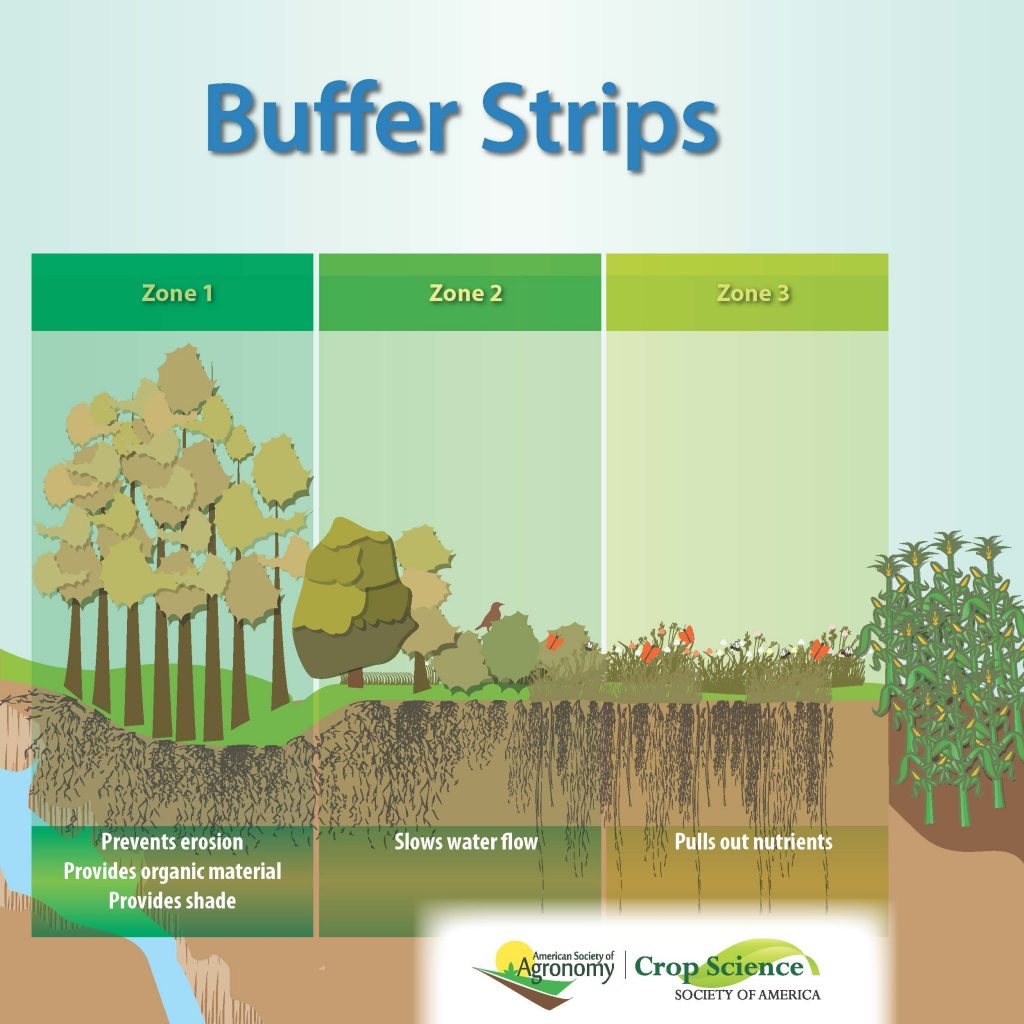
Features
Production
Research
What are riparian buffer strips?
September 25, 2018 By Amanda Ramcharan Pennsylvania State University
 ASA/CSSA/SSSA staff
ASA/CSSA/SSSA staffThe word “riparian” refers to the place where streams meet land. This important intersection controls a lot of processes – especially with regard to water quality. Human use of land near streams can negatively impact the purity of the water. And, the aquatic ecosystem is important to overall environmental health.
A variety of plant and animal life call these streams their home. Creating strips of vegetation, called buffer strips, is something that scientists have found helps protect these aquatic systems.
“Riparian buffer strips” is the technical term that agronomists use to refer to buffer strips on the edge of farm fields.
This technique had long been used in Southern Europe for agricultural land. During the 1960s, scientists studied the benefits of leaving riparian buffer strips on the forest land. In the Pacific Northwest industrial forestry was expanding.
Riparian buffer strips were found to protect salmon populations from forest harvesting activities. Soon enough, riparian buffers became the primary tool for protecting freshwater ecosystems.
Riparian buffer strips can be used for industrial, residential, or even agricultural use.
A few of the benefits of riparian buffer strips are:
- reduce sediment loss from upslope terrain;
- provide shade and moderate temperature;
- maintain bank stability;
- recharge groundwater;
- protect aquatic habitat;
- provide wildlife habitat; and,
- enhance nutrient uptake.
Since the 1960s, they have only grown in popularity. As a tool to manage and protect freshwater resources, they are relatively easy to administer and operate. Many states provide resources and financial incentives to support landowners build or restore buffers.
How are riparian buffer strips built or maintained? A riparian buffer is usually made up of three zones with the first zone at the water’s edge. Zones two and three move further inland.
Each zone has a different width and mixture of plants that depends on the size of the water body, and the desired functions of the buffer. Each zone of the riparian buffers protect freshwater ecosystems in different ways.
Zone one usually gets planted with large trees and shrubs. Tree and shrub roots promote bank stability. Even the leaves of the trees can slow down the flow of a heavy rainfall onto the soil. This helps prevent erosion of the soil. Not only is it important to keep the soil where it is, it’s important to keep the soil out of the streams.
The leaf canopy provides shade for the much of the riparian area. This shade in this zone can keep the water temperature cooler for fish. Falling leaves and branches provide organic materials for the stream. They even provide resources for animals that live near streams, like beavers (to read more on that, visit here https://www.soils.org/discover-soils/story/beavers-take-chunk-out-nitrogen-northeast-rivers).
Trees also provide a habitat for insects that fish feed on, and provide nesting areas for birds. Plants in zone one need to be very tolerant to wet conditions.
The second zone is usually a managed forest or a mixed forest shrub land. Zone two is usually planted with native shrubs and small trees like American holly, inkberry, persimmon, and gray dogwood.
Tree roots in this zone can slow down water flow from human land use. This improves the flow of water back to groundwater sources, instead of into the stream. The trees also use many of the nutrients that are running off agricultural land. This reduces the amount of nutrients that get to the stream.
Zone three is furthest away from the water source, right next to the human use (besides agricultural land, it could be an urban area, parking lot, or even an industrial site.)
Zone three is planted with grassland or a mix of grassland and wild flowers. If you’re in a residential or urban area, this area can even be a garden. Zone three also contributes to slowing down nutrient runoff and trapping sediment. This zone can attract many beautiful species of birds, butterflies, and moths on to your landscape.
There are many technical aspects to the design of a riparian buffer zone which depends on what the aquatic ecosystem needs. A few examples of these technical details include determining:
- the width of the buffer strip;
- what the land use is adjacent to your property;
- the slope of the land;
- soil conditions;
- current stream health; and,
- creation of corridors to connect habitat for wildlife.
There are many programs to help both farmers and residential landowners design a riparian buffer project. Given the range of benefits a riparian buffer can provide, I think it’s probably pretty easy to find a riparian buffer project near you.
Print this page